Bài giảng Lập trình trên Windows với Microsoft.NET - Phần 4
public class Point
{
public int m_x;
public int m_y;
public Point (){ }
public Point(int xx,int yy)
{
m_x = xx ;
m_y = yy;
}
public static Point operator + (Point p1,Point p2) {
Point result = new Point();
result.m_x = p1.m_x + p2.m_y;
result.m_y = p1.m_x + p2.m_y;
return result;
}
}
static void Main(string[] args)
{
Point objP1 = new Point(1,1);
Point objP2 = new Point(2,2);
Point objResult = new Point();
objResult = objP1 + objP2;
Console.WriteLine("The result is m_x = {0} and m_y = {1}", objResult.m_x , objResult.m_y);
}

Trang 1

Trang 2
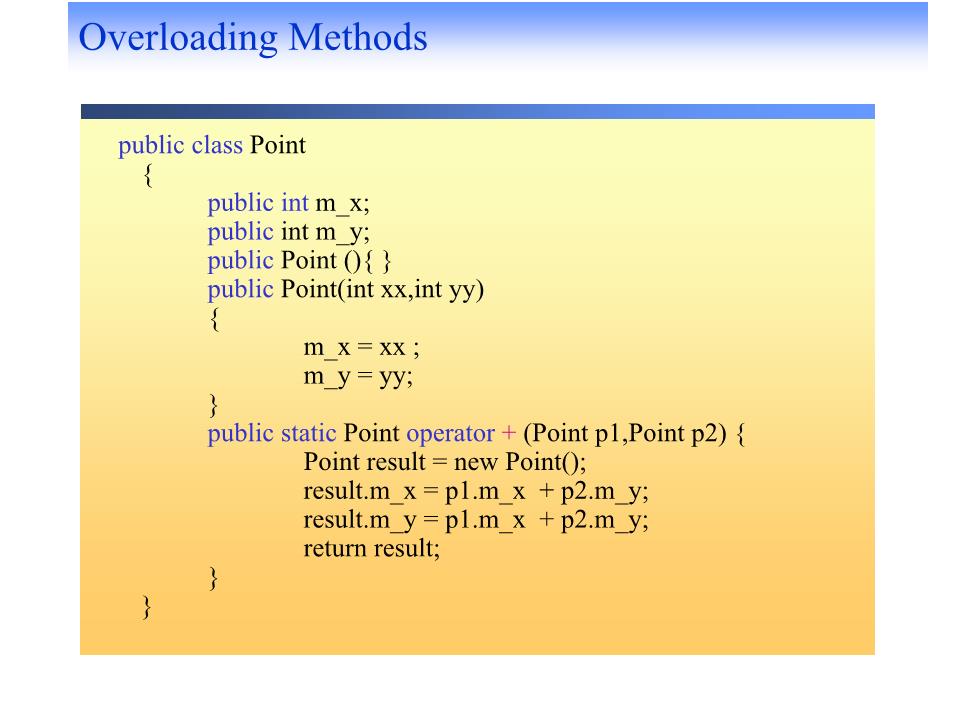
Trang 3
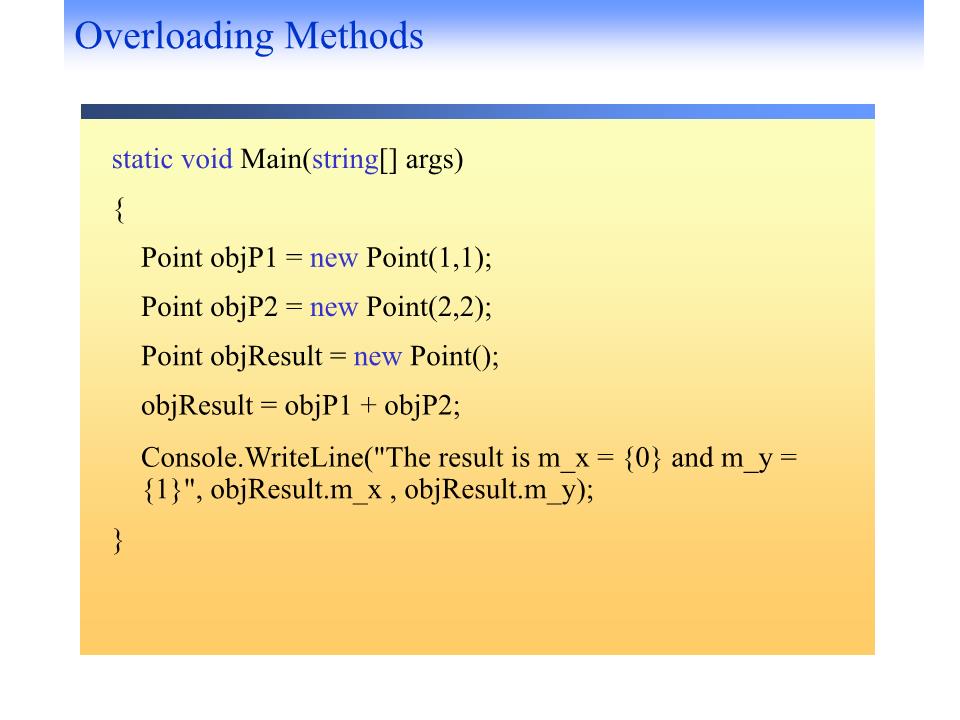
Trang 4
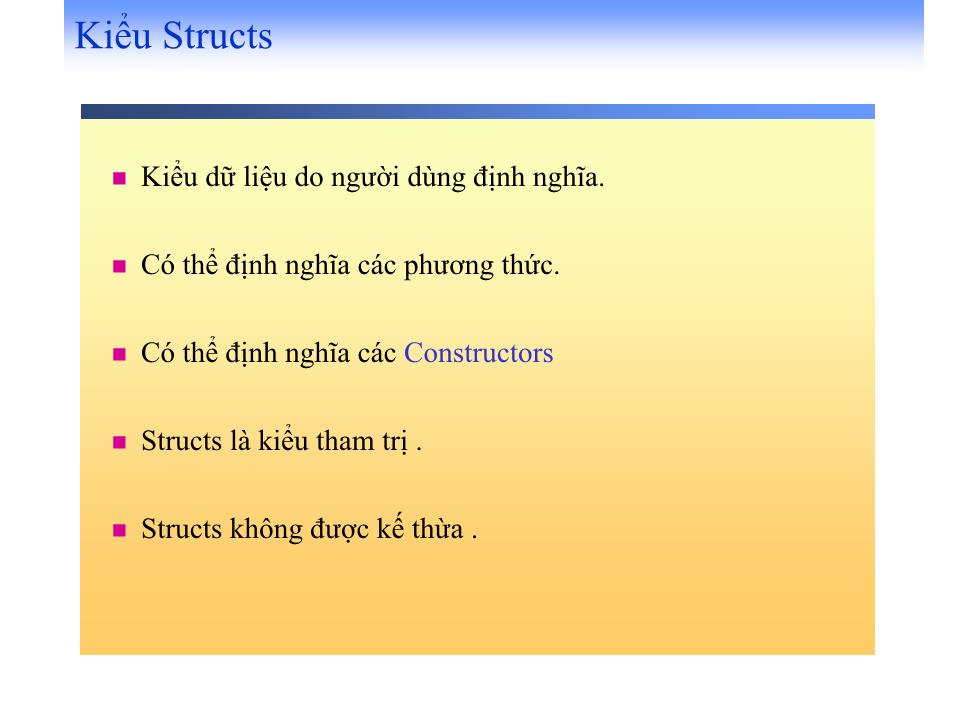
Trang 5
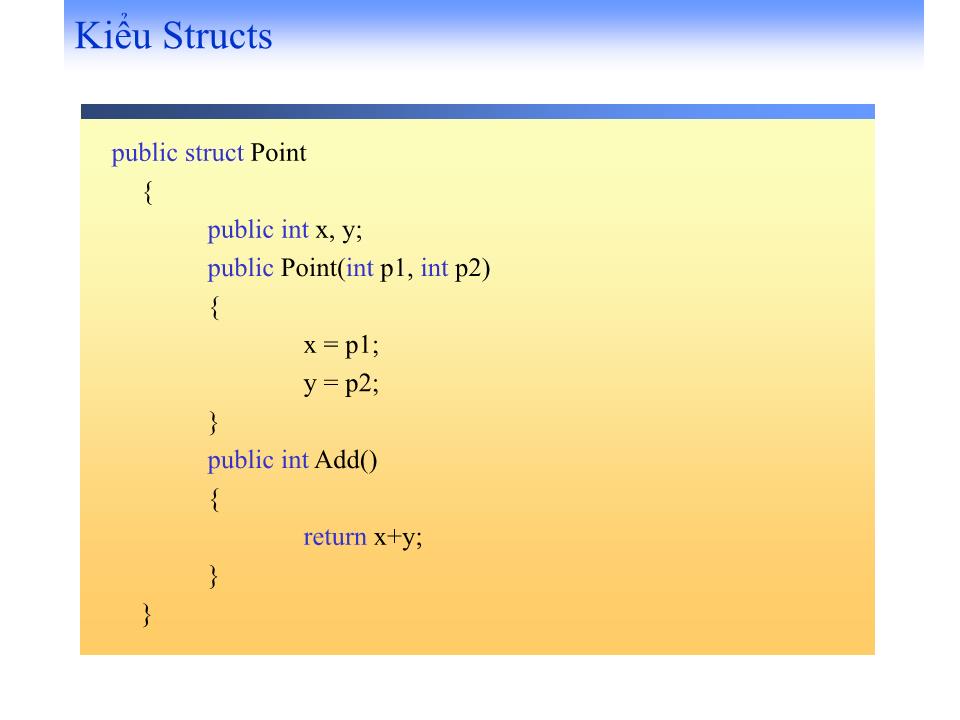
Trang 6
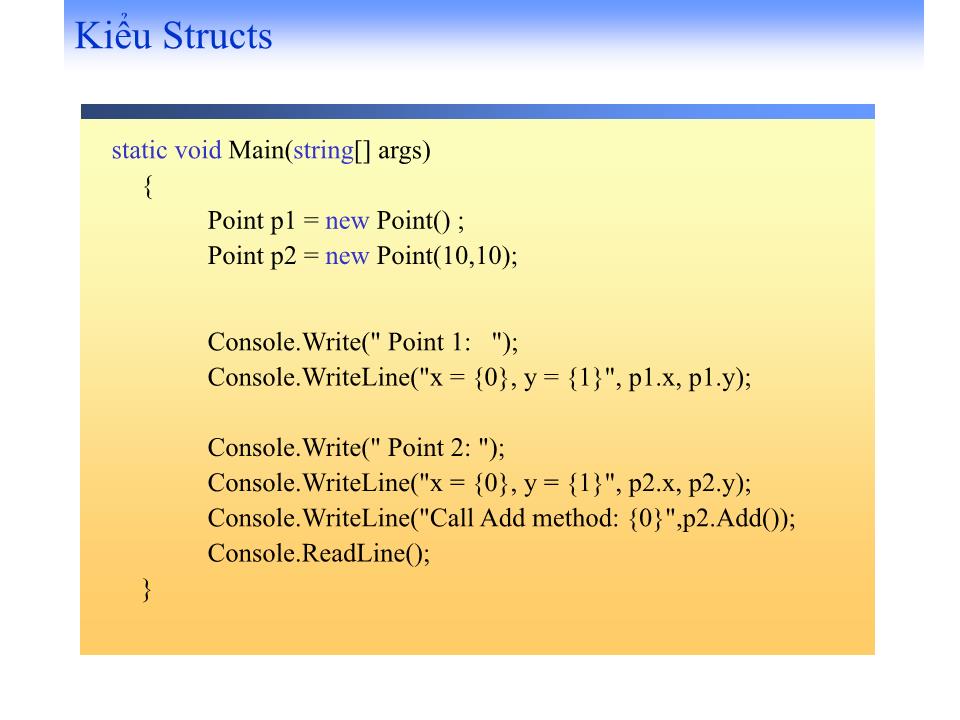
Trang 7
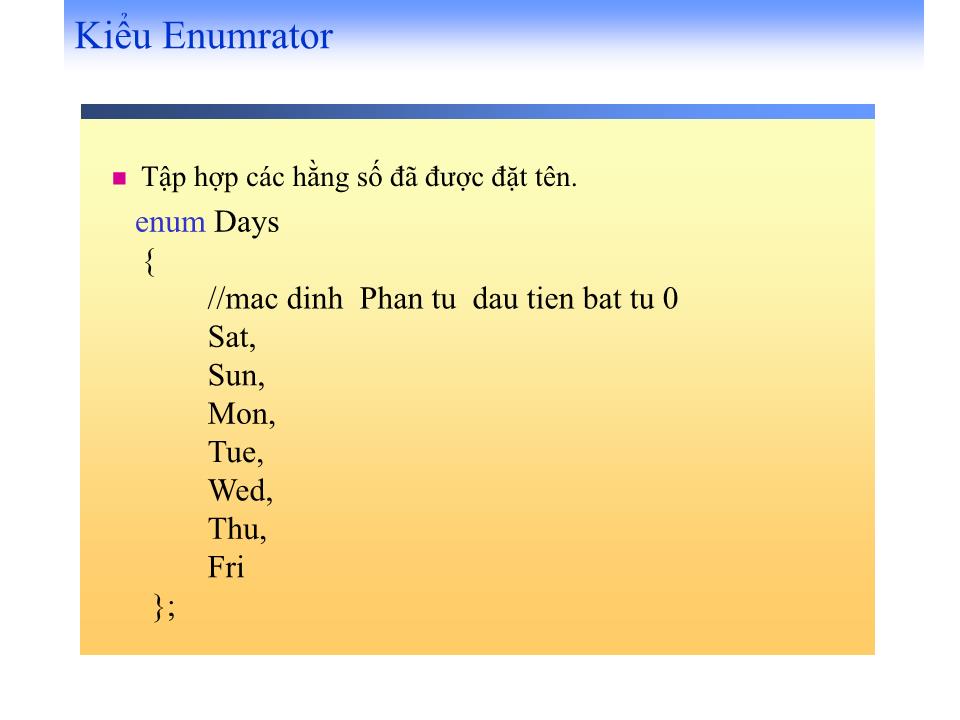
Trang 8
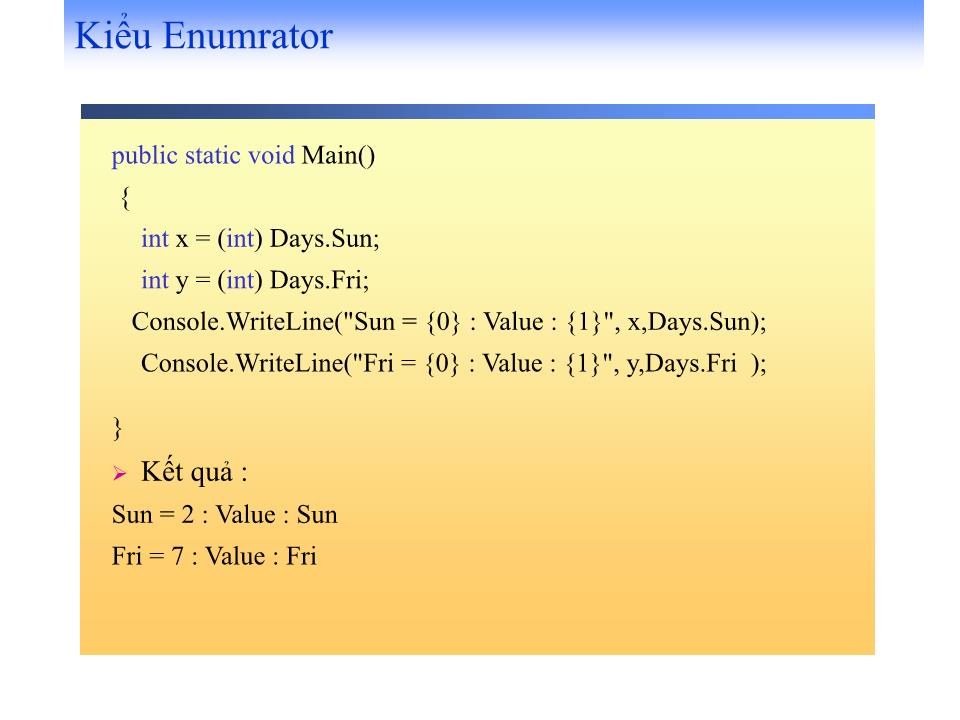
Trang 9
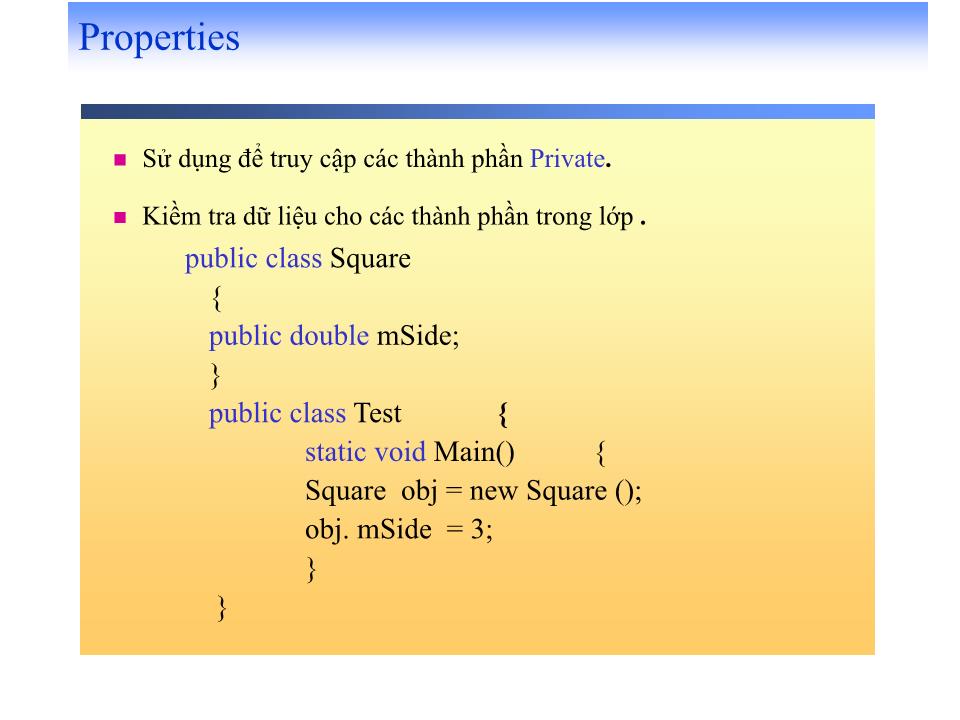
Trang 10
Tải về để xem bản đầy đủ
Bạn đang xem 10 trang mẫu của tài liệu "Bài giảng Lập trình trên Windows với Microsoft.NET - Phần 4", để tải tài liệu gốc về máy hãy click vào nút Download ở trên
Tóm tắt nội dung tài liệu: Bài giảng Lập trình trên Windows với Microsoft.NET - Phần 4
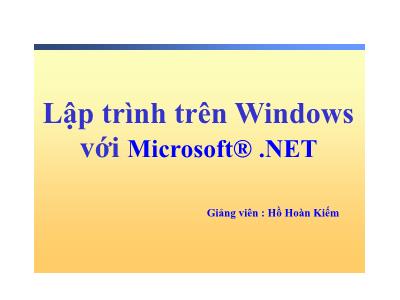
Lập trình trên Windows với Microsoft® .NET
Giảng viên : Hồ Hoàn Kiếm
Overloading Methods
Áp dụng cho các toán tử :
Overloading Methods
public class Point
{
public int m_x;
public int m_y;
public Point (){ }
public Point(int xx,int yy)
{
m_x = xx ;
m_y = yy;
}
public static Point operator + (Point p1,Point p2) {
Point result = new Point();
result.m_x = p1.m_x + p2.m_y;
result.m_y = p1.m_x + p2.m_y;
return result;
}
}
Overloading Methods
static void Main( string [] args)
{
Point objP1 = new Point(1,1);
Point objP2 = new Point(2,2);
Point objResult = new Point();
objResult = objP1 + objP2;
Console.WriteLine("The result is m_x = {0} and m_y = {1}", objResult.m_x , objResult.m_y);
}
Kiểu Structs
Kiểu dữ liệu do người dùng định nghĩa.
Có thể định nghĩa các phương thức.
Có thể định nghĩa các Constructors
Structs là kiểu tham trị .
Structs không được kế thừa .
Kiểu Structs
public struct Point
{
public int x, y;
public Point( int p1, int p2)
{
x = p1;
y = p2;
}
public int Add()
{
return x+y;
}
}
Kiểu Structs
static void Main( string [] args)
{
Point p1 = new Point() ;
Point p2 = new Point(10,10);
Console.Write(" Point 1: ");
Console.WriteLine("x = {0}, y = {1}", p1.x, p1.y);
Console.Write(" Point 2: ");
Console.WriteLine("x = {0}, y = {1}", p2.x, p2.y);
Console.WriteLine("Call Add method: {0}",p2.Add());
Console.ReadLine();
}
Kiểu Enumrator
Tập hợp các hằng số đã được đặt tên.
enum Days
{
//mac dinh Phan tu dau tien bat tu 0
Sat,
Sun,
Mon,
Tue,
Wed,
Thu,
Fri
};
Kiểu Enumrator
public static void Main()
{
int x = ( int ) Days.Sun;
int y = ( int ) Days.Fri;
Console.WriteLine("Sun = {0} : Value : {1}", x,Days.Sun);
Console.WriteLine("Fri = {0} : Value : {1}", y,Days.Fri );
}
Kết quả :
Sun = 2 : Value : Sun
Fri = 7 : Value : Fri
Properties
Sử dụng để truy cập các thành phần Private .
Kiềm tra dữ liệu cho các thành phần trong lớp .
public class Square
{
public double mSide;
}
public class Test {
static void Main() {
Square obj = new Square ();
obj. mSide = 3;
}
}
Properties
public class Square
{
//Khi báo các thành phần
private double mSide;
// Khai báo property
public double Side
{
get { };
set { };
}
// Khai báo các phương thức
}
Properties
Property giống như field , nhưng việc truy cập đươc thực hiện qua thao tác get và set .
public int Side
{
get
{
return mSide;
}
set
{
if (mSide < 0) return ;
mSide = value ;
}
}
Properties
namespace SampleProperty
{
public class Rectangle
{
private int m_Length ;
private int m_Width ;
private int m_Area ;
public Rectangle()
{
m_Length = 3; // Length = 3;
m_Width = 2;
}
Properties
public int Length
{
get
{
return m_Length;
}
set
{
if (m_Length < 0 ) return ;
m_length = value ;
}
}
Properties
public int Width
{
ge t
{
return m_Width;
}
set
{
// Đọan mã kiểm tra giá trị ..
m_Width = value ;
}
}
Properties
public int Area
{
get
{
return m_Area;
}
}
public void CalArea()
{
m_Area = m_Length*m_Width;
}
Properties
public class Test
{
public static void Main()
{
Rectangle objRectangle = new Rectangle();
objRectangle. Length = 3;
objRectangle. Width = 4;
objRectangle.CalArea();
Console.WriteLine("{0}", objRectangle. Area );
}
}
Indexer
Khi thành phần của lớp là các kiểu tập hợp.
Sử dụng với : new, virtual, sealed, override, abstract, extern .
Indexer giống như Property , đuợc truy cập thông qua get và set
Khai báo sử dụng từ khóa this.
Khi sử dụng Indexer ta sử dụng dấu [] cho get và set .
Indexer
class IndexerClass
{
private int [] myArray = new int [100];
public int this [ int index]
{
get {
If (index = 100) return 0;
else
return myArray[index];
}
set {
if (!(index = 100))
myArray[index] = value ;
}
}
}
Indexer
public class Test
{
public static void Main()
{
IndexerClass b = new IndexerClass();
b[3] = 256;
b[5] = 1024;
for ( int i=0; i<=10; i++)
{
Console.WriteLine("Element # {0} = {1}", i, b[i]);
}
}
}
File đính kèm:
 bai_giang_lap_trinh_tren_windows_voi_microsoft_net_phan_4.ppt
bai_giang_lap_trinh_tren_windows_voi_microsoft_net_phan_4.ppt

